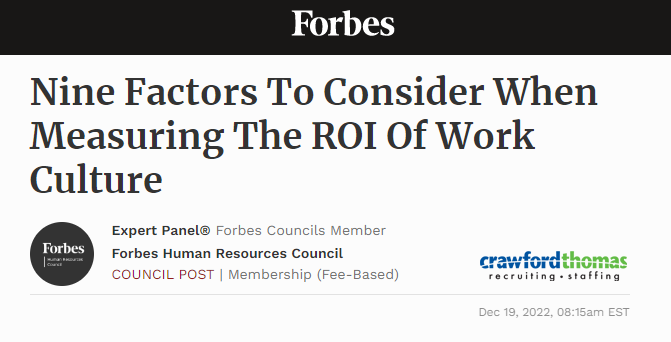Forbes Human Resources Council
Original Article here

Oftentimes, during the job search and interviewing process, a potential job candidate may be drawn into a company’s image of a positive company culture that seems to be a great fit and career move at the time only to be disappointed with their decision to accept the position later.
So how can an employer ensure that its organization is rooted in integrity and will continue to live up to its company mission, values and culture throughout the years? It’s not always easy to pinpoint the potential return when investing in your company’s culture, so that is why Forbes Human Resources Council members discuss specific areas to keep in mind when leaders are measuring ROI to ensure that current and potential employees understand how much they mean to the growth of their organization.
1. Real-Time Employee Engagement
Leaders can measure the return on investment for their company culture by turning vision into action. They can do this by quantifying the actions of employees against the business outcomes. Going beyond annual surveys and measuring employee participation and engagement across key moments creates real-time estimations. Leaders who are highly agile, attuned and plugged in can create a culture that fosters engagement. – Julie Hankins, NNIT
2. Accountability And Demonstration Of Cultural Standards
The ROI on company culture depends on the leadership. Often, culture is used to get candidates to opt into the interview process. It can be a powerful way to communicate behavioral expectations and norms. However, if people are not held accountable to cultural standards or rewarded for consistently demonstrating them, it can disengage people. Engagement surveys, departure data and tenure studies will also help you measure ROI. – Lisa Feher, Secure Code Warrior
3. Net Promoter Scores
There’s a metric referred to as the employee Net Promoter Score (NPS). It asks employees how likely they are to recommend their organization as a place to work for others, gauging how they feel about the company’s internal culture. More importantly, high NPS scores tend to correlate with stronger profit and shareholder growth, so beyond culture, NPS is a good measure of ROI overall. – John Morgan, LHH
4. Multiple Key Performance Indicators
When it comes to measuring the ROI of company culture, a stand-alone calculation can’t be used. However, combining several key performance indicators (KPIs) can. As high-performing culture is infectious, getting unintentionally integrated into every process, interaction, decision and action. Measuring engagement, unscheduled absenteeism, internal promotions, recruiting costs, retention rates and internal referrals are KPIs that can be combined to measure the ROI of your culture. – JacLyn Pagnotta, Allied Partners
5. A Foundation Of Belonging
There is a direct positive path to the bottom line that can be traced through workplace culture. Specifically, when the culture is one that is rooted in belonging, offering its support, continual improvement and honesty, leaders will find that their employees stay around longer and are more engaged and fulfilled. When things are not going well, everyone willingly plays a part in finding solutions to challenges. – Niki Ramirez, HRAnswers.org
6. An Increase In Productivity, Innovation And Retention
The value of culture is simultaneously immeasurable and equally attributable to increased productivity, innovation and employee or client retention. If your employees come to work happy and are looking forward to their day, they may forget they are at work. – William Stonehouse, Crawford Thomas Recruiting
7. A Successful Employee Referral Program
There are many ways to measure ROI on a company’s culture, but a key indicator that I have continued to utilize is an employee referral program. If employees are happy, feel valued and understand that their contributions directly impact the organization’s culture and success, they will refer friends and former co-workers for job openings. This has been a significant and reliable metric of ROI of culture for leadership. – Kelly Hutchinson, Big Communications
8. Customer Retention And Satisfaction
Measuring the ROI of culture requires clear articulation of the desired culture, how it will drive organizational strategy and metrics that demonstrate the culture’s impact on organizational results. For example, if customer retention is a key organizational metric, defining a customer-centric culture enables ROI measurement through customer retention, customer satisfaction and revenue metrics. – Jennifer Rozon, McLean & Company
9. External Consultant Feedback
There is value in HR departments leveraging external consultants for data analysis to ensure unconscious bias mitigation. Surveys and other data such as attrition rates, performance data, referral rates, wellness data and exit interviews can also be some of the most valuable drivers of people strategy. – Cynamon Voe Scott, DuploCloud Inc.
About Crawford Thomas Recruiting:
Crawford Thomas is a team of leading HR recruiters. We not only fill staffing needs, we partner with organizations to find out how their recruiting needs tie into their business objectives. Through this, we are able to meet your staffing needs in a way that achieves organizational success.
Start securing top talent by visiting our page for employers today.

